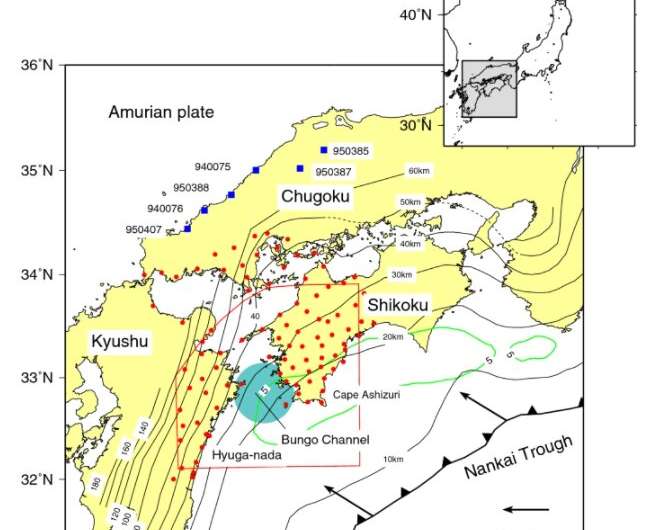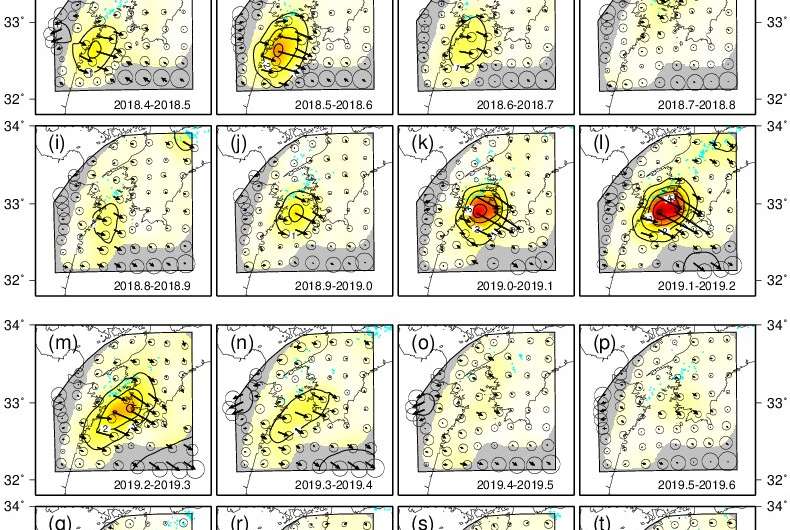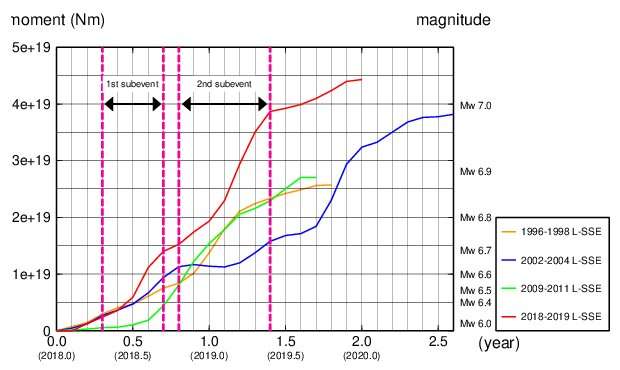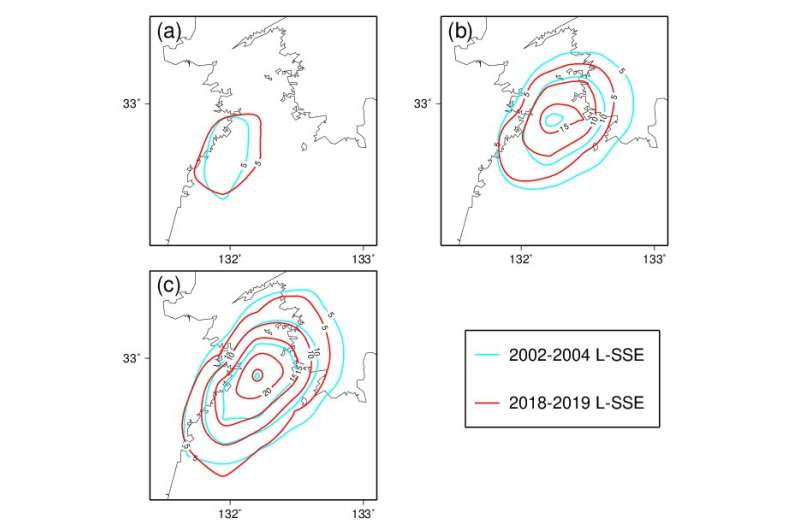Better prediction of megathrust earthquakes: Illuminating slow slip plate tectonics in south-western Japan

Within the next 30 years, a highly destructive Nankai Trough megathrust earthquake is predicted to hit southwest Japan. Understanding long-term slow slip events (L-SSE) that occur along the plate interface between the subducting Philippine Sea plate and overriding Amurian plate under the Bungo Channel is essential for pinpointing when such an earthquake will happen. To this end, Kobe University's Professor YOSHIOKA Shoichi (Research Center for Urban Safety and Security) and SESHIMO Yukinari (1st year Masters student, Department of Planetology, Graduate School of Science) analyzed the 2018-2019 Bungo Channel L-SSE using longitudinal GNSS data provided by the Geospatial Information Authority of Japan.
They revealed that even though the 2018-2019 event was shorter than past L-SSEs in this region, it was also bigger in terms of slippage amount and slip velocity, as well as seismic moment and moment magnitude. This and their other findings provide further insight into the behavior of L-SSEs in the Bungo Channel.
These results were publicized in the online journal Scientific Reports on January 10, 2022 at 10 am GMT.
Main points
- Illuminating slow slip distribution in the Bungo Channel is important for understanding the causal mechanism behind a Nankai Trough megathrust earthquake, which has been predicted to occur in the near future.
- This research group illuminated the spatiotemporal distribution of the slow slip event that occurred in 2018-2019
- Despite taking place over the shortest time period, the 2018-2019 event was the highest recorded so far in terms of slippage amount and slip velocity, as well as seismic moment and moment magnitude compared to past slow slip events in the Bungo Channel.
- The 2018-2019 event resembled the 2002-2004 slow slip in terms of starting location, slip distribution and the order in which sub-events occurred.

Research background
In the Bungo Channel, which is located between Shikoku and Kyushu in southwest Japan, the Philippine Sea plate is subducting in a north-westerly direction beneath the Amurian plate. Every 6 or so years, long-term slow slip events (L-SSE) repeatedly occur along the plate interface beneath this region. Each of these L-SSEs last between several months to a couple of years.
Studies conducted up until now have analyzed the slip distributions of L-SSEs that occurred in the following periods: 1996-1998, 2002-2004, and 2009-2011. It has been indicated that there is a possible relationship between these events and the occurrence of a Nankai Trough megathrust earthquake.
Illuminating the slip distributions of L-SSE in the Bungo Channel is considered vital for understanding how such a megathrust earthquake occurs. Therefore, Kobe University researchers decided to conduct a new analysis of the L-SSE that happened during the 2018-2019 period.
Research methodology and findings
Using longitudinal GNSS data, the researchers calculated the spatiotemporal distribution of the Bungo Channel L-SSE that occurred in 2018-2019. From the results, they understood that this event could be divided into 2 sub-events; the 1st sub-event spanning March to July 2018 (0.1 of a year = 36.5 days) and occurring under the southwest side of the Bungo Channel, and the 2nd sub-event that occurred from August 2018 to April 2019 directly beneath the central part of the Channel.

The 2018-2019 L-SSE, at one year in duration, lasted for the shortest length of time compared to past Bungo Channel L-SSEs that have been analyzed. Despite this, the 2018-2019 L-SSE was the biggest event in terms of slippage amount and slip velocity, as well as seismic moment and moment magnitude. Furthermore, the researchers also discovered that the 2018-2019 L-SSE was similar to the 2002-2004 L-SSE in terms of starting location, slip distribution and the order in which sub-events occurred. In the past, there have been intervals of approx. 6 years between the occurrence of each L-SSE, however the 2018-2019 L-SSE took place around 8 years after the previous event, which was in 2009-2011.

Further Research
The Bungo Channel L-SSEs have taken place at the downdip of the plate interface adjacent to the hypocenter of the Nankai Trough megathrust earthquake, which is estimated to occur with a 70~80% probability in the next 30 years. Monitoring the spatiotemporal changes in the behavior of these kinds of slow earthquake is vital for enabling seismologists to detect the early signs of a megathrust earthquake. These observations have revealed spatiotemporal changes in the slip distribution of the 2018-2019 Bungo Channel L-SSE, highlighting the great importance of comparing recent L-SSE with past events. Next, the researchers will monitor the slippage and adhesion where the plates intersect beneath the Bungo Channel. By furthering their analysis, they hope to illuminate the mechanisms by which earthquakes occur and to enable the early detection of the coming Nankai Trough megathrust earthquake.
More information: Yukinari Seshimo et al, Spatiotemporal slip distributions associated with the 2018–2019 Bungo Channel long-term slow slip event inverted from GNSS data, Scientific Reports (2022). DOI: 10.1038/s41598-021-03982-6
Journal information: Scientific Reports
Provided by Kobe University





















